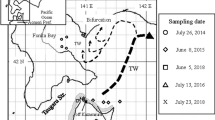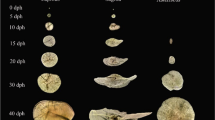Abstract
This paper aims to validate the micro increment deposition in the sagittal otoliths of young of the year (YOY) Lithognathus mormyrus in the shallow waters of Çanakkale, Turkey. Wild YOY specimens of L. mormyrus were captured and reared to validate the daily micro increment formation in sagittal otoliths. The formation of daily sagittal micro increments was validated using by alizarin Red S (ARS), at a concentration of 0 (control), 50 mg/lt, 100 mg/lt, 150 mg/lt, 200 mg/lt and 300 mg/lt. The natural photoperiod was applied, and no food was given throughout the marking period. The tanks kept strongly aerated to maintain the pH ~ 7. YOY fish were kept in different aquariums for 17 days post-dyeing and then re-dyeing as before and kept alive for a further 20 days. ARS marks were clearly observed in 71.7% of the YOY L. mormyrus sagittal otoliths under a fluorescent microscope. However, no mark could be observed in any of the samples of 50 mg/lt ARS treatment. Chi2 tests revealed that the linear regressions of the number of micro increments between ARS marks against number of elapsed times was not statistically significant. This result showed that micro increment deposition on the sagitta were laid down daily under the experimental conditions and can be used to detect the daily age information for YOY L. mormyrus.





Similar content being viewed by others
Availability of Data and Materials
Not applicable.
References
Bashey F (2004) A comparison of the suitability of alizarin red S and calcein for inducing a nonlethally detectable mark in juvenile guppies. Trans Am Fish Soc 133:1516–1523
Bauchot ML, Hureau JC (1986) Sparidae. In: Whitehead PJP, Bauchot ML, Hureau JC, Nielsen E (eds) Fishes of the north-eastern Atlantic and the Mediterranean. UNESCO, Paris, pp 883–907
Bauchot ML, Hureau JC (1990) Sparidae. In: Clofeta II, Quero JC, Hureau JC, Karrer A, Saldanha Post L (eds) Check-list of the fishes of the eastern tropical Atlantic. UNESCO, Paris, pp 790–812
Beamish RJ, McFarlane G (1983) The forgotten requirement for age validation in fisheries biology. Trans Am Fish Soc 112:735–743
Campana SE, Neilson JD (1985) Microstructure of fish otoliths. Can J Fish Aquat Sci 42:1014–1032
Carvalho MG, Moreira AS, Moreira C, Queiroga H, Santos PT, Correia AT (2014) Validation of otolith daily increments in early juveniles of shanny Lipophrys pholis. J Fish Biol 84:1234–1239
Dougherty AB (2008) Daily and sub-daily otolith increments of larval and juvenile walleye pollock, Theragra chalcogramma (Pallas), as validated by alizarin complexone experiments. Fish Res 90:271–278
Durham BW, Wilde GR (2008) Validation of daily growth increment formation in the otoliths of juvenile cyprinid fishes from the Brazos River, Texas. North Am J Fish Manag 28:442–446
Fischer AJ, Chesney EJ, Cowan JH (2010) Validation of first annulus formation in red snapper otoliths with the use of an alizarin complexone fluorescent marker. Environ Biol Fishes 89:313–317
Harmelin-Vivien M, Harmelin J, Leboulleux V (1995) Microhabitat requirements for settlement of juvenile sparid fishes on Mediterranean rocky shores. In Space partition within aquatic ecosystems. Springer, pp 309–320
Hettler WF (1984) Marking otoliths by immersion of marine fish larvae in tetracycline. Trans Am Fish Soc 113:370–373
Jenkins GP, Wheatley MJ, Poore AGB (1996) Spatial variation in recruitment, growth, and feeding of postsettlement King George whiting, Sillaginodes punctata, associated with seagrass beds of Port Phillip Bay, Australia. Can J Fish Aquat Sci 53:350–359
Jones CM (1992) Development and application of the otolith increment technique. Otolith microstructure examination and analysis, Book 117. Can Spec Publ Fish Aquat Sci 117
Lagardere F, Thibaudeau K, Anras MLB (2000) Feasibility of otolith markings in large juvenile turbot, Scophthalmus maximus, using immersion in alizarin-red S solutions. ICES J Mar Sci 57:1175–1181
Lang JB, Buxton CD (1993) Validation of age estimates in sparid fish using fluorochrome marking. South African Journal of Marine Science-Suid-Afrikaanse Tydskrif Vir Seewetenskap 13:195–203
Liu Q, Zhang X, Zhang P, Nwafili S (2009) The use of alizarin red S and alizarin complexone for immersion marking Japanese flounder Paralichthys olivaceus (T.). Fish Res 98:67–74
Lorenzo J, Pajuelo J, Méndez-Villamil M, Coca J, Ramos A (2002) Age, growth, reproduction and mortality of the striped seabream, Lithognathus mormyrus (Pisces, Sparidae), off the Canary Islands (central-east Atlantic). Journal of Applied Ichthyology 18(3):204–209
Mansur L, Catalan D, Plaza G, Landaeta MF, Ojeda FP (2013) Validations of the daily periodicity of increment deposition in rocky intertidal fish otoliths of the south-eastern Pacific Ocean. Rev Biol Mar Oceanogr 48:629–633
Miller BS, Kendall AW (2009) Early life history of marine fishes, Vol 36. University of California Press Berkeley
Moralesnin B, Gutierrez E, Massuti S (1995) Patterns of primary growth increments in otoliths of Sparus-aurata larvae in relation to water temperature and food-consumption. Sci Mar 59:57–64
Nakaya M, Morioka T, Fukunaga Y, Sekiya S, Jinbo T, Nagashima H, Ueno Y (2008) Validation of otolith daily increments for larval and juvenile Japanese halfbeak Hyporhamphus sajori. Fish Res 93:186–189
Namiki S, Tanaka H, Katayama S, Funaki O, Aoki I, Oozeki Y (2010) Validation of daily increment formation in otoliths of immature and adult Japanese anchovy Engraulis japonicus. Fish Sci 76:951–959
Neilson JD, Geen GH (1982) Otoliths of chinook salmon (Oncorhynchus-tshawytscha) - daily growth increments and factors influencing their production. Can J Fish Aquat Sci 39:1340–1347
Neilson JD, Geen GH, Bottom D (1985) Estuarine growth of juvenile chinook salmon (Oncorhynchus-tshawytscha) as inferred from otolith microstructure. Can J Fish Aquat Sci 42:899–908
Pajuelo J, Lorenzo J (2002) Age and growth of the annular seabream, Diplodus annularis (Pisces: Sparidae), from the Canarian Archipelago (Central-east Atlantic). Ciencias Marinas 28(1):1–11
Pannella G (1971) Fish otoliths: daily growth layers and periodical patterns. Science 173:1124–1127
Parkinson KL, Booth DJ, Lee JE (2012) Validation of otolith daily increment formation for two temperate syngnathid fishes: the pipefishes Stigmatopora argus and Stigmatopora nigra. J Fish Biol 80:698–704
Partridge GJ, Jenkins GI, Doupe RG, De Lestang S, Ginbey BM, French D (2009) Factors affecting mark quality of alizarin complexone-stained otoliths in juvenile black bream Acanthopagrus butcheri and a prescription for dosage. J Fish Biol 75:1518–1523
Pérez-Mayol S, Alvarez I, Riera-Batle I, Grau A, Morales-Nin B (2021) Validating the growth increment periodicity in the otoliths of three small progenetic gobies. Sci Mar 85(3):169–173
Rigg AL, Bellotto C, Fowler AM, Booth DJ (2023) Staining protocols affect use of otolith to estimate the demography of the damselfish sergeant major (<i>Abudefduf vaigiensis</i>). J Fish Biol. https://doi.org/10.1111/jfb.15601
Secor DH, Dean JM, Laban EH (1991) Manual for otolith removal and preparation for microstructural examination. Electric Power Research Institute Belle W. Baruch Institute for Marine Biology and Coastal Research., Palo Alto, Calif., Columbia, South Carolina
Sponaugle S, Cowen RK (1994) Larval durations and recruitment patterns of 2 caribbean gobies (Gobiidae) - contrasting early-life histories in demersal spawners. Mar Biol 120:133–143
Takahashi M, Yoneda M, Kitano H, Kawabata A, Saito M (2014) Growth of juvenile chub mackerel Scomber japonicus in the western North Pacific Ocean: with application and validation of otolith daily increment formation. Fish Sci 80:293–300
Taylor MD, Fielder DS, Suthers IM (2005) Batch marking of otoliths and fin spines to assess the stock enhancement of Argyrosomus japonicus. J Fish Biol 66:1149–1162
Tonkin Z, King AJ, Robertson A (2008) Validation of daily increment formation and the effects of different temperatures and feeding regimes on short-term otolith growth in Australian smelt Retropinna semoni. Ecol Freshw Fish 17:312–317
Tsukamoto K, Kuwada H, Hirokawa J, Oya M, Sekiya S, Fujimoto H, Imaizumi K (1989) Size-dependent mortality of red-sea bream, Pagrus-major, juveniles released with fluorescent otolith-tags in news bay, Japan. J Fish Biol 35:59–69
Van der Walt B, Faragher RA (2003) Otolith marking of rainbow trout fry by immersion in low concentrations of alizarin complexone. North Am J Fish Manag 23:141–148
Vigliola L (1997) Validation of daily increment formation in otoliths for three Diplodus species in the Mediterranean sea. J Fish Biol 51:349–360
Villanueva R, Moli B (1997) Validation of the otolith increment deposition ratio using alizarin marks in juveniles of the sparid fishes, Diplodus vulgaris and D-puntazzo. Fish Res 30:257–260
Weber D, Ridgway GJ (1967) Marking Pacific salmon with tetracycline antibiotics. Journal of the Fisheries Board of Canada 24:849–865
Wilson DT, McCormick MI (1997) Spatial and temporal validation of settlement-marks in the otoliths of tropical reef fishes. Mar Ecol Prog Ser 153:259–271
Withers JL, Markley N, Davis L, Kehler T, Sweka J (2019) Labeling Calcified Structures in Young Lake Sturgeon: A Comparison of Oxytetracycline Hydrochloride, Alizarin Red S, And Calcein. North Am J Fish Manag 39:1217–1226
Yang K, Li S, Liu XS, Gan WX, Deng LJ, Tang YZ, Song ZB (2017) Mass marking of juvenile Schizothorax wangchiachii (Fang) with alizarin red S and evaluation of stock enhancement in the Jinping area of the Yalong River. Peerj 5
Funding
Türkiye Bilimsel ve Teknolojik Araştırma Kurumu, 118O321.
Author information
Authors and Affiliations
Contributions
Ayyildiz, H. wrote the main manuscript text and prepared figures. Kurtkaya, E, Altin, A. and Bulut, M. conducted field and laboratory studies. Çelik, P. conduct aquaculture process and all authors reviewed the manuscript.
Corresponding author
Ethics declarations
Ethical Approval
The care and use of experimental animals complied with [Çanakkale Onsekiz Mart University, Animal Experiments Local Ethics Committee] animal welfare laws, guidelines and policies as approved by [2018/02–10].
Competing Interests
Not applicable.
Additional information
Publisher's Note
Springer Nature remains neutral with regard to jurisdictional claims in published maps and institutional affiliations.
Rights and permissions
Springer Nature or its licensor (e.g. a society or other partner) holds exclusive rights to this article under a publishing agreement with the author(s) or other rightsholder(s); author self-archiving of the accepted manuscript version of this article is solely governed by the terms of such publishing agreement and applicable law.
About this article
Cite this article
Ayyıldız, H., Kurtkaya, E., Çelik, P. et al. Validation of Daily Growth Increment Deposition in Sagittal Otoliths of the Young of the Year Lithognathus mormyrus. Thalassas (2024). https://doi.org/10.1007/s41208-024-00686-2
Received:
Revised:
Accepted:
Published:
DOI: https://doi.org/10.1007/s41208-024-00686-2




